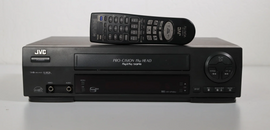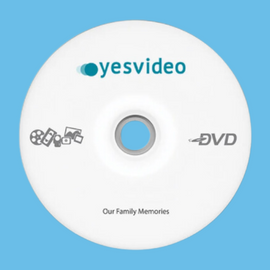
VHS, Beta, Hi8 and DV tapes were once popular video cassette formats for recording home videos. Each had its own unique features and strengths, as well as many limitations. None of the tapes were designed to preserve the video contents for more than a few decades.
VHS
VHS (Video Home System) is an analog video cassette format that was first introduced in 1976. It quickly became the dominant format for consumer video recording and playback, replacing earlier formats such as Beta.
VHS tapes offered several advantages over earlier video formats. They had a larger cassette size, which allowed for longer recording times of up to 6 hours. This made VHS tapes more convenient for recording television shows and movies, as fewer tapes were needed. In addition, VHS tapes were more affordable and widely available, making them accessible to a wider range of consumers.
Another key factor in VHS's success was the widespread adoption of the format by Hollywood studios, which released movies on VHS tapes for rental or purchase. This helped to drive consumer adoption of VHS and cemented its position as the dominant consumer video format.
Over the years, VHS tapes faced increasing competition from other video formats, such as Beta and later, digital formats such as MiniDV and DVD. However, VHS tapes remained popular for many years, particularly among consumers who had large collections of VHS tapes and VHS players.
Today, VHS is considered a discontinued format, and many devices that could play VHS tapes are no longer produced. However, some video enthusiasts still have collections of VHS tapes, and there are companies that specialize in converting analog tapes to digital formats for preservation purposes. Despite its decline, VHS remains an important part of video history, representing a major shift in consumer video technology and culture.
Beta
Beta is an analog video cassette format that was introduced as a competitor to VHS in the late 1970s. Betamax was developed by Sony and was designed to offer superior picture and sound quality compared to VHS.
Beta tapes used a smaller cassette size compared to VHS, which limited recording time to just over an hour. This made Beta tapes less convenient for recording television shows or movies, as multiple tapes were often needed for longer content.
Despite its superior picture and sound quality, Beta faced several challenges in the market. It was more expensive than VHS tapes and required specialized Beta-only equipment, which made it less accessible to consumers. Additionally, the smaller cassette size made Beta tapes less durable and more prone to damage compared to VHS tapes.
Despite these challenges, Beta was still popular among videophiles and early adopters who appreciated its superior quality. However, as VHS tapes became more affordable and widespread, Beta tapes eventually declined in popularity.
Today, Beta is considered a discontinued format, and many devices that could play Beta tapes are no longer produced. However, some video enthusiasts still have collections of Beta tapes, and there are companies that specialize in converting analog tapes to digital formats for preservation purposes.
Hi8
Hi8 (High Band 8mm) is a type of analog video cassette format that was introduced in 1985 as an improvement over the earlier Video8 format. Hi8 tapes were similar in size to Video8 tapes, but they used a higher quality recording process, which resulted in improved picture and sound quality.
Hi8 tapes were popular among amateur videographers and home video enthusiasts due to their compact size, portability, and affordability. They offered a step up from earlier analog formats, such as VHS, in terms of image and sound quality, and were widely used for recording family events, vacations, and other special moments.
One of the key benefits of Hi8 tapes was their compatibility with analog editing equipment, which made it possible to edit footage on a home VCR or a dedicated analog editing deck. However, this process was limited compared to digital editing, as it was prone to image degradation and loss of quality.
Despite their popularity, Hi8 tapes faced increasing competition from digital video formats, such as MiniDV, which offered improved picture and sound quality and the convenience of digital editing. As a result, Hi8 tapes eventually became less relevant, and many consumers made the switch to digital video formats.
Today, Hi8 tapes are largely considered to be a discontinued format, and many devices that could play Hi8 tapes are no longer produced. However, some video enthusiasts still have collections of Hi8 tapes, and there are companies that specialize in converting analog tapes to digital formats for preservation purposes.
Digital Video (DV) Tape
Digital Video (DV) tapes were a type of digital video cassette format used for recording and playing back video content. They were introduced in 1995 and represented a major shift from analog video formats, such as VHS and Beta, towards digital recording.
One of the key benefits of DV tapes was the improved picture and sound quality. DV tapes used digital compression to record video, which eliminated the degradation and loss of quality that was common with analog formats. The small size of the DV tapes also made them more portable and convenient to use.
Another advantage of DV tapes was their compatibility with digital editing software. This allowed users to easily transfer footage from a DV tape to a computer and edit it using software such as Adobe Premiere or Final Cut Pro. This made it easier for amateur filmmakers and video enthusiasts to create high-quality videos.
In addition to consumer use, DV tapes were also popular for professional video production. They were widely used for independent filmmaking, documentaries, and news production due to their affordability and convenience.
However, the widespread adoption of high-definition video and the increasing popularity of tapeless digital recording methods, such as solid-state memory cards and hard disk drives, have largely replaced DV tapes in the modern era. Today, DV tapes are largely considered to be a discontinued format.

Each of the analog video cassette formats “ VHS, Beta, Hi8, and DV “ had its own unique features and strengths, as well as its own set of limitations. While VHS was the dominant format for many years, the introduction of Beta, Hi8, and later, digital formats, challenged its position and offered consumers new options for recording and playing back video content.
Today, all of these formats have been largely replaced by digital formats, such as DVD and online streaming, which offer improved picture and sound quality, convenience, and accessibility. However, these analog formats remain an important part of video history, representing a critical moment in the evolution of video technology and culture.
Despite their decline, some enthusiasts and collectors still have collections of analog tapes, and there are companies that specialize in converting analog tapes to digital formats for preservation purposes. As a result, the legacy of these analog formats will continue to live on, offering a glimpse into the history of video technology and the moments that shaped our culture.

